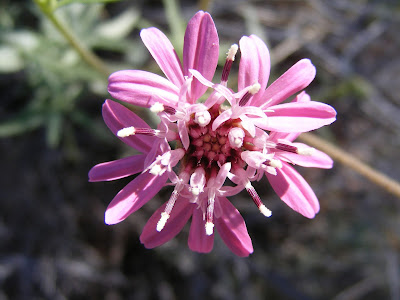 |
| Just west of the mountain |
 |
| Distracted by something |
 |
| Barrel Cactus flower buds |
 |
| Two trails diverged in a high desert, and we took the one on the right |
 |
| I love the flower girl |
 |
| Waiting for Godot? No--for Packrat |
 |
| Ocotillo wands bent toward the sun (foreground) |
 |
| Sand Palafox |
 |
| Palafoxia hookeriana |



6 comments:
I like the different shades of pink in that flower.
You're dating yourself with that reference to "I love the flower girl," Packrat! Our fields are full of dragonflies, too. Where do you think they are breeding in the desert? Do you think they could be breeding in the Rio Grande and then moving out into other territory for feeding?
That's as good a theory as any I can imagine, Scott, but there are so many more than in the past I can't think of a scenario to explain the increased numbers. I did do some research and found the info on Desert USA to be quite interesting.
http://www.desertusa.com/insects/dragonflies.html
Funny blog post title!
Only ever see dragonflies by water here. We have lots of canals and often see them there
Funny you should mention that, Liz. In researching the increased number of dragonflies issue I discovered the following from the BBC.
http://news.bbc.co.uk/earth/hi/earth_news/newsid_9469000/9469163.stm
The article to which you provided a link is good; thank you. However, dragonfly and damselfly immatures are properly called nymphs (as the article correctly starts out calling them, then incorrectly switches to the term larvae). Larva is the term used for insects that undergo complete metamorphosis; that is, the organism passes through egg, larva, pupa, and adult phases. Insects like odonates (the dragonflies and damselflies) pass only through three phases: egg, nymph, and adult phases, and thus undergo incomplete metamorphosis.
I'd forgotten how close-by Dripping Springs is to you. I would imagine that habitats like Dripping Springs (and maybe other smaller hidden springs) could provide appropriate habitat that's closer to Tortugas and the surrounding desert than the Rio Grande.
Post a Comment